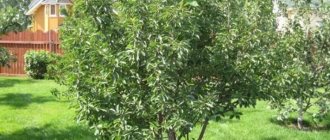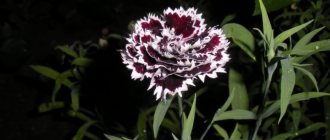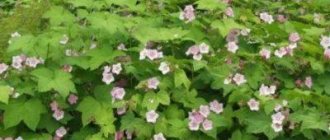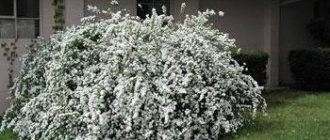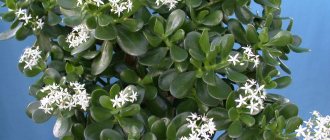I really like thujas. But have you noticed how similar our dachas, designed by professional landscape designers, are? I just want to add some kind of mischief to the carefully designed hedge of strict thuja Columna, to create a sunny highlight in stylish compositions with thuja Smaragd...
When I saw a photo of a yellow ribbon thuja, I realized: this is it – a yellow ribbon, or better yet, a yellow bow will give that sunny note that is so needed in our summer, which is not generous with sunny days.
So, Thuja occidentalis “Yellow Ribbon” is the heroine of our story today.
Description of thuja occidentalis Yellow ribbon
Thuja occidentalis yellow ribbon is called the most valuable variety of thuja with golden colored needles. And this is no coincidence: young soft needles in the spring amaze with an orange tint. By summer the color changes to golden green, and by winter the color of noble bronze emerges. This thuja is a real impressionist dream: it is different every day!
Appearance
The height of an adult tree is 2.0 - 2.5 m. It reaches these values in 15 years. The annual growth is 10-12 cm. At the same time, the diameter of the crown changes more slowly: in an adult plant it is 0.8 m, increasing by 8 cm annually. The shape of the plant is conical, or, more precisely, teardrop-shaped. The crown is dense due to a large number of densely located branched shoots.
In autumn, small brown cones ripen, somewhat reducing the decorative value of the plant.
Looking at this plant, you just want to say: “What a neat compact plant!”
The root system is superficial, well branched.
Weather resistance
Of the more than 200 species of thuja, only the western thuja can withstand Russian frosts. Thuja Yellow Ribbon even stands out here: its frost resistance threshold is -35 degrees.
Thujas do not like drafts, but our heroine is wind-resistant, she can withstand not only a draft, but also a fairly strong wind. The main thing is that it does not dry out the crown or the soil in the tree trunk too much.
Due to the light (bronze) shade of winter needles, they do not suffer from spring sunburn, but young (up to 2 years old) plants are recommended to be protected from the bright spring sun.
Preferences
Thuja is unpretentious, its soil requirements are the absence of groundwater. But it will show all its beauty on fertile light loams and sandy loams.
Soil acidity can be neutral or slightly acidic. The optimal pH ranges from 4.5 to 6.5.
Thuja loves moist soil, but does not tolerate constantly damp soil - such conditions contribute to the development of root blight, against which thuja is powerless.
Thuja does not like either the bright midday sun (its needles can get burned) or dense shade. In the absence of sun, the tree becomes loose, loses its shape and exotic color. In the dense shade, instead of a flirtatious yellow ribbon, green ruffles will grow.
The optimal place for it is lacy light partial shade or morning (evening) sun for 6-8 hours.
Thuja does not really like the neighborhood of active large trees: poplar, birch, maple. These giants capture the nutrient layer of the soil with their powerful roots. Thuja, which has only superficial roots, remains on a starvation diet.
How to choose the right thuja seedling
Exotic types of thuja are in great demand among gardeners, so their “production” has been put on stream. They can be found especially often at spontaneous roadside garden markets. Shopping in these markets is a lottery. You can pay a lot of money, and the plant, which looked so beautiful from the seller, will wither despite all the efforts of the gardener.
If you still decide to buy a seedling not from a nursery, then remember the main thing:
- It is better to buy plants with a closed root system: their survival rate is much higher at any time of planting. Ask the seller to remove the seedling from the container. If the plant is easily released from the pot, it means that it was put there just before the sale. This seedling is not worth buying. A plant grown in a pot is difficult to separate from it! Roots may be peeking out of the drainage holes of the container - this is the kind of seedling that suits you.
- Touch the crown of the thuja. It should be elastic, lively, and not crumble with little effort. The color corresponding to the varietal color is also evidence of a quality seedling. Touch the needles with wet hands or a damp cloth: unscrupulous sellers paint the needles of simple varieties “to look like exotic ones.” If your hands or napkins are clean, the thuja is its own color.
- Inspect the branches and trunk. Pay attention to damage, it may be caused by pests. This specimen will be sick for a long time.
- If you buy a plant with an open root system, then special attention should be paid to the roots. They should not have mold, signs of rot, swelling or thickening.
Such control does not need to be carried out if the thuja is purchased from a nursery. As a rule, such seedlings have been treated with insecticides and phytoncides and grow in the soil most suitable for them, seasoned with long-acting fertilizers. These plants have a full range of thuja varietal characteristics.
Pests and diseases
The thuja aphid is the most common parasite. Colonies of brown insects lead to wilting and falling of needles. Treatment is carried out with conventional insecticides, soap solution and other means.
Important! When treating, you need to cover the roots of the plant so that harmful substances do not have a negative effect on them.
Moths cause more damage than aphids. Its larvae gnaw through thuja branches, leading to the death of entire shoots. Treatment consists of pruning the affected shoots and treating with pyrethroids. For example, “Tornado Antiklesch” or “Moskitol Antiklesch”.
Thuja is often susceptible to fungal diseases
Other pests are very rare. The main thing is to notice changes on the shoots of the plant in time, because in the early stages the treatment will be faster, and the damage from parasites will be minimal.
When is the best time to plant thuja yellow ribbon?
For thuja with a closed root system, there are no restrictions on planting time. The only thing you need to remember is that the thuja must take root in the soil before the autumn frosts. This means that you need to plant it a month before their onset.
For plants with an open root system, there is the following rule:
- for southern regions with hot summers and mild winters, more gentle planting of young plants in the fall;
- For northern regions, planting in the spring is optimal, then the plant will gain strength before winter frosts.
Reproduction
Thuja Yellow Ribbon is propagated by both seed and vegetative methods.
The seeds are collected in mid-autumn and planted in a container in the spring. In autumn, young plants are picked. And after 3 years you can transplant it into open ground.
Cuttings are a faster method, although they do not allow you to get as many new trees.
The cuttings are cut at the end of summer, and the middle parts of last year's shoots are selected. Placed in fertile soil on the site or at home, covered with film to create a greenhouse effect. In the first case, they need to be covered for the winter, and in the second, they need to be lowered into the basement. In the spring, transplantation is carried out to the selected location.
Some gardeners manage to propagate thuja by layering. In the spring, the lower shoot is buried and covered for the winter. The following year, in the summer, the new plants that have formed are cut off and transplanted to the desired area.
Rules for planting thuja
For comfortable growth of thuja, even one as compact and slowly growing as Yellow Ribbon, a planting hole is required that is 20 cm larger than the container in all dimensions.
At the bottom it is necessary to create a drainage layer of expanded clay, broken brick, and river pebbles. Fill the hole halfway with nutritious soil, consisting of sand, peat and garden soil in a ratio of 1:1:2. The soil is filled with complete complex fertilizer at the rate of 1 tablespoon of fertilizer per bucket of nutrient soil mixture.
The seedling is transferred from the container to the planting hole, making sure that the root collar remains flush with the surface of the earth.
Cover with the remaining soil, compacting it so that no air voids remain.
The seedling is watered abundantly with water with the addition of a root formation stimulator.
Caring for thuja yellow ribbon
Despite its exotic appearance, this thuja variety is quite unpretentious. However, standard care procedures still need to be followed.
These include:
- watering;
- feeding;
- loosening;
- weeding;
- pruning
Watering
Thuja yellow ribbon is moisture-loving; in hot weather it is watered generously 2-3 times a week, at the rate of 1 bucket per plant. When the temperature drops, the frequency of watering is reduced to once a week.
“Yellow Ribbon” is very responsive to sprinkling: its needles become even brighter after irrigation, and the smell of fresh needles spreads over several meters.
Top dressing
For the first 2 years after planting, thuja is not fed; after this period, preference is given to potassium-phosphorus fertilizers.
It is important! Large amounts of nitrogen are contraindicated for slow-growing plants, which include Thuja Yellow Ribbon.
It is permissible only in early spring in small quantities at the beginning of sap flow. An excessive dose of nitrogen weakens the root system of the thuja due to the redistribution of plant forces to increased crown growth. Externally, this is manifested by a violation of the shape and looseness of the crown.
At the same time, phosphorus and potassium strengthen the roots and branches, as a result of which the decorative appearance of the plant improves.
For the same reason, thujas are not fertilized with fresh manure and large amounts of organic matter.
It is optimal to use special fertilizers for conifers.
Loosening and weeding
These 2 operations are very important for thuja: its roots are located at a depth of only 8-10 cm from the surface of the earth, so it is necessary to ensure aeration and access to nutrients. Frequent weeding and loosening can be replaced by mulching the tree trunk circle after watering.
Trimming
Thuja yellow ribbon does not need regular shaping haircuts: its slow growth and dense crown allow it to maintain its desired shape.
Sanitary pruning, during which damaged and dried shoots are removed, is carried out throughout the entire growing season.
If, when executing a design plan, it is necessary to give the thuja a shape different from its natural one, you need to remember:
- no more than 1/3 of the shoots are cut off in one operation;
- The thuja will stop growing if the top is cut off;
- a branch cut close to the trunk will not regenerate.
Examples of use in landscape design
Single trees look great due to their bright colors
An example of an original hedge in which green and golden options alternate
Golden thujas are great for complex landscaping
Summary
- This is a variety of compact cone-shaped thuja with a height of no more than 2.5 m and a width of up to 0.8 m.
- Thuja has an exotic color: from yellow-orange in spring to bronze in autumn.
- Yellow ribbon is frost-hardy and wind-resistant.
- This variety of thuja prefers moist soils, abundant watering and regular sprinkling.
- In general, thuja is unpretentious; a standard set of caring procedures and moderate feeding are enough for it.
If you don't want your cottage to resemble a place of eternal peace, let the sun into your garden! Let yellow bows appear there - neat, graceful thujas “Yellow Ribbon”. And you will have “a little sun in cold water.”
